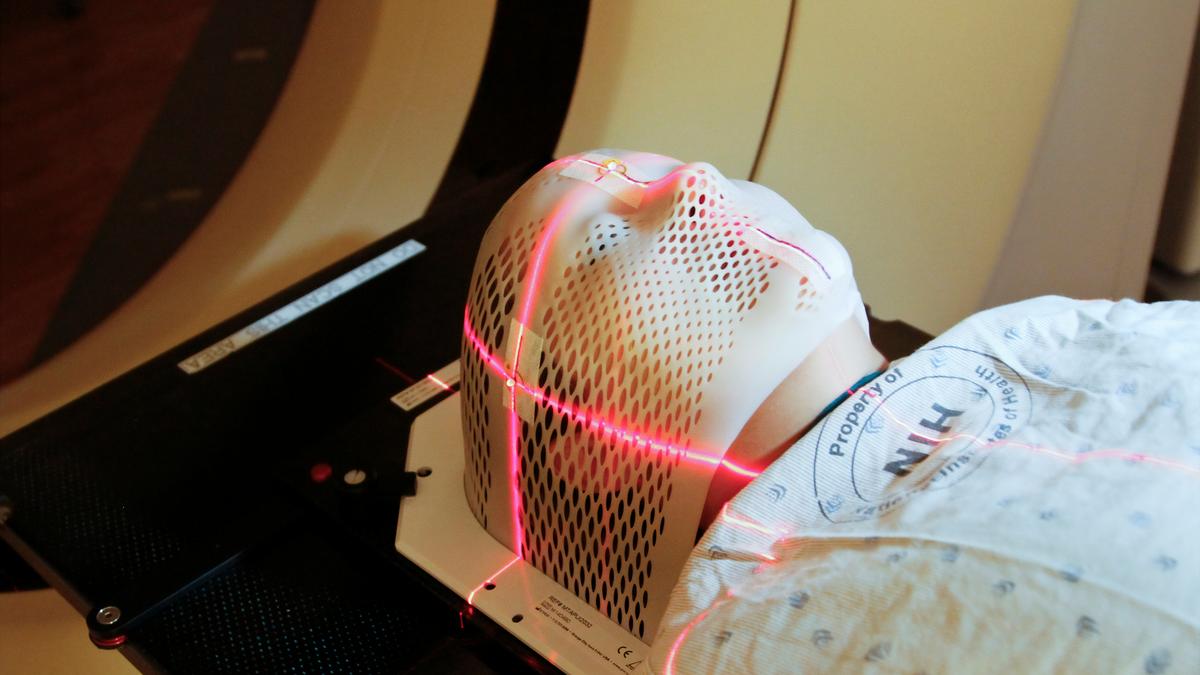Lasers are used to position a patient model wearing a face mask in a CT scanner to obtain images of a tumour before radiation therapy. Representative image.
| Photo Credit: USNCI
A team of experts in the U.S. has successfully used a technique called step-and-shoot spot-scanning proton arc therapy (SPArc) to treat a patient’s adenoid cystic carcinoma for the first time. SPArc works by targeting tumours with protons while sparing surrounding tissue.
The findings of the team, at the Corewell Health William Beaumont University Hospital, were published in the June 2025 issue of the International Journal of Particle Therapy.
The team compared the results of three techniques: SFO-IMPT (the current standard of care), step-and-shoot SPArc, and fully dynamic SPArc (simulated with computers). The SPArc methods reduced radiation delivered to the brainstem (by 10%), optical chiasm (56%), oral cavity (72%), and spinal canal (90%) over SFO-IMPT.
“This is definitely significant,” Narayana Subramanian, lead consultant, Head and Neck Surgical Oncology at Aster International Institute of Oncology, Bengaluru, said. “In tumours of the head and neck, limiting dose delivery to organs at risk is a major consideration of treatment planning. When these organs receive a higher dose of radiation than they can tolerate, they undergo irreparable damage.”
While fully-dynamic SPArc performed better, the difference between the two arc styles was small, the team wrote. In dynamic SPArc, the dose’s energy and point of delivery is constantly adjusted, whereas in step-and-shoot the machine follows a pre-programmed pattern.
The researchers wrote that dynamic SPArc is still under development and awaits regulatory clearance and integration with existing oncology information systems.
Multi-technique protocol
The first person to receive step-and-shoot SPArc was a 46-year-old woman whose parotid-gland cancer had spread along her facial nerve towards the base of her skull. In June-August 2024, the team said she completed 33 sessions with step-and-shoot SPArc. During this, the woman reportedly had “minor skin irritation” and no issues eating or continuing working. According to the American Cancer Society, conventional side-effects of radiation therapy for head and neck cancers include fatigue, nausea, trouble swallowing, etc.
Dr. Subramaniam said the technology is “likely to be valuable in tumours that are located in anatomically complex areas like the skull base … where dose delivery has to be precise with reduced spillage to surrounding critical areas. It’s also likely to be valuable in large or extensive tumours, where the tumour can be targeted accurately with limited collateral damage to the surrounding tissues.”
The treatment protocol included a computer programme that scanned through all possible spots and energy layers where the proton beams could be delivered. An energy layer is a slice of tissue that receives proton beams of a specific energy. The energy determines the beam’s range: how far it is able to penetrate the tissue. When the machine fixes one energy level, its scanning nozzle sweeps dozens of suitable spots and deposits the radiation dose in that energy layer. Then the machine switches to the next energy level and repeats the process, this time delivering a beam with a little more range. This way the whole tumour is ‘painted’ with radiation.
In each session, once the woman was in position, the team performed a cone-beam computed tomography (CBCT) scan. A machine-learning model converted the CBCT data into a synthetic CT with which the team could track the doses to be delivered. Over the first two weeks, synthetic CT revealed the woman had lost weight and the tumour dose coverage had thus slipped 3-5%. The team adjusted for this from the 13th day.
The gantry was set up to have nine beam angles covering a 180º arc around the woman. It delivered one dose, moved 20º, delivered the second, moved 20º, delivered the third, and so on. The paper said each session took 15-18 minutes and the treatment benefited from the near-continuous radiation delivery.
The SFO-IMPT and (simulated) dynamic SPArc methods used the same target plan and had the same goals: deliver a fixed total dose in 33 daily treatments and ensure the proton range isn’t off by more than 3.5%.
“With very precise radiotherapy delivery, the concern is that small tumours can be missed, referred to as geographical miss, as movements as subtle as breathing can change their position, and they can shrink in size over the course of treatment and result in inferior cancer cure rates,” Dr. Subramaniam said.
“Another significant concern is cost,” he added. “These technologies are very expensive and are often suitable for a small patient population. This results in a significant financial burden on the healthcare system and the risk that it may be used in situations where it is not indicated.”
Published – June 15, 2025 05:00 am IST
